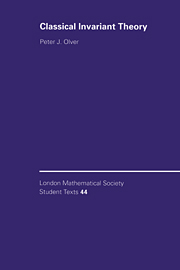Book contents
- Frontmatter
- Contents
- Introduction
- 1 Prelude — Quadratic Polynomials and Quadratic Forms
- 2 Basic Invariant Theory for Binary Forms
- 3 Groups and Transformations
- 4 Representations and Invariants
- 5 Transvectants
- 6 Symbolic Methods
- 7 Graphical Methods
- 8 Lie Groups and Moving Frames
- 9 Infinitesimal Methods
- 10 Multivariate Polynomials
- References
- Author Index
- Subiect Index
6 - Symbolic Methods
Published online by Cambridge University Press: 08 January 2010
- Frontmatter
- Contents
- Introduction
- 1 Prelude — Quadratic Polynomials and Quadratic Forms
- 2 Basic Invariant Theory for Binary Forms
- 3 Groups and Transformations
- 4 Representations and Invariants
- 5 Transvectants
- 6 Symbolic Methods
- 7 Graphical Methods
- 8 Lie Groups and Moving Frames
- 9 Infinitesimal Methods
- 10 Multivariate Polynomials
- References
- Author Index
- Subiect Index
Summary
In the classical approach to invariant theory, the symbolic method originally introduced by Aronhold, and Clebsch, plays a pivotal role. By appealing directly to the omega process and related differential operators, we have effectively bypassed this classical algebraic technique. In fact, when restricted to homogeneous polynomials, our approach can be directly reduced to the classical method. The connection between the two is made via a transform which, like the Fourier transform of classical analysis, changes questions about derivatives and differential polynomials into questions about ordinary algebraic polynomials, thus making them amenable to the powerful techniques of commutative algebra and invariant theory. Unfortunately, unlike the Fourier transform, which plays a vital role in the solution of linear partial differential equations, the nonlinear transform does not appear to be of much use for actually solving nonlinear differential equations. Nevertheless, its power for studying algebraic and geometric properties has been amply documented.
A special case of this transform was first introduced by Gel'fand and Dikii, in their study of integrable soliton equations, inverse scattering problems, and the calculus of variations. It was generalized by Shakiban, who used it to apply the invariant theory of finite groups to the study of conservation laws of differential equations. The connections between the transform method and the classical symbolic method were first recognized, in slightly different form, in. The present version is essentially the same as that used by Ball, Currie, and Olver, to classify null Lagrangians, with applications to non-convex variational problems arising in nonlinear elasticity.
Information
- Type
- Chapter
- Information
- Classical Invariant Theory , pp. 99 - 127Publisher: Cambridge University PressPrint publication year: 1999
